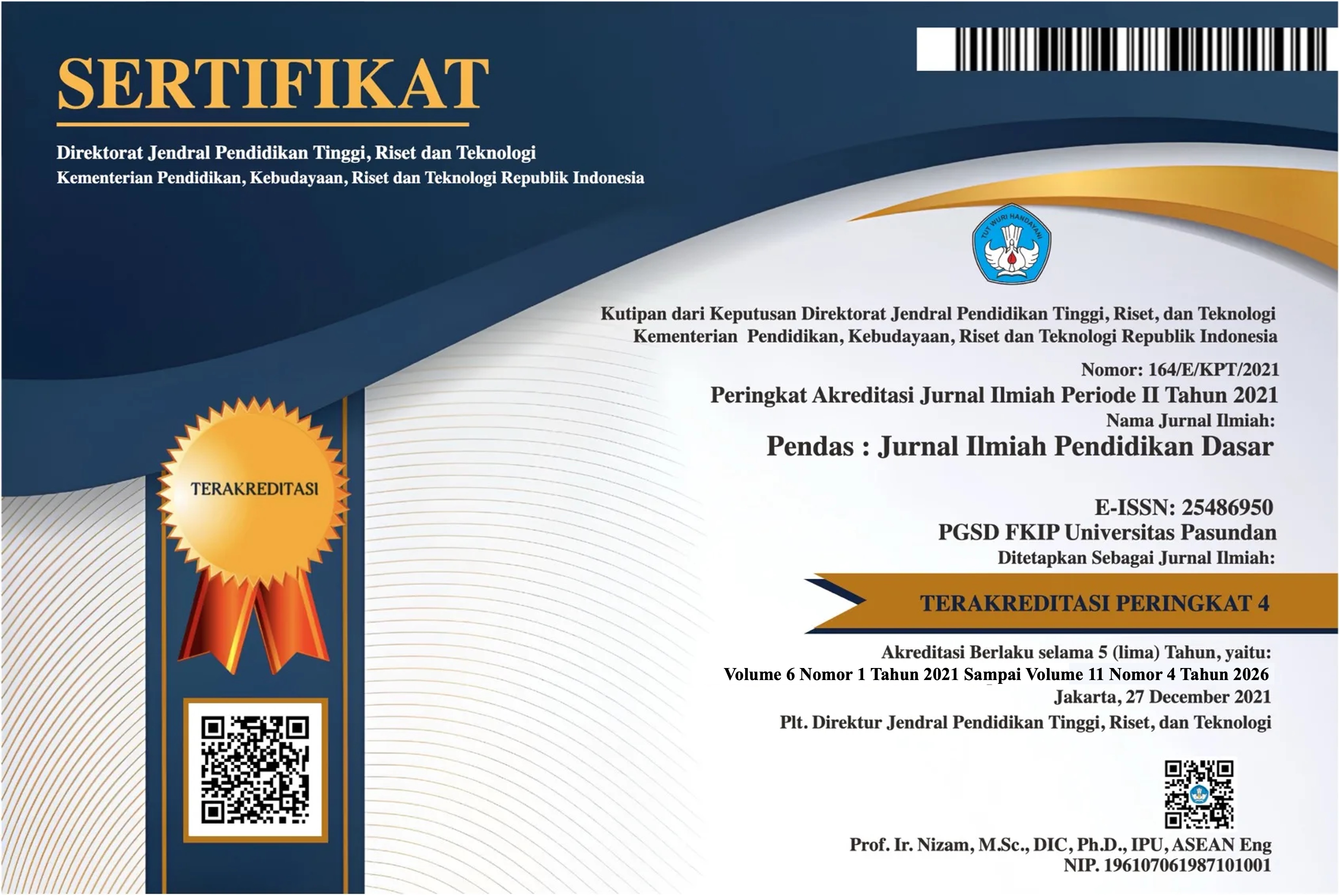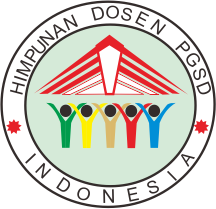PEMBUDAYAAN MEMBACA PERMULAAN PADA PESERTA DIDIK KELAS I MELALUI PENERAPAN METODE READ ALOUD
DOI:
https://doi.org/10.23969/jp.v9i03.16390Keywords:
early reading, read aloud method, lower grade studentsAbstract
This study aims to describe the implementation of the Read Aloud method in fostering early reading habits among first-grade students at MI Muhammadiyah Karanganyar. The approach used in this research is qualitative with a case study design. Data collection methods include interviews, observations, and documentation. Data analysis techniques involve data reduction, data presentation, and drawing conclusions. The findings of this study demonstrate that the implementation of the Read Aloud method at MI Muhammadiyah Karanganyar has proven to have a positive impact on fostering reading habits among first-grade students. Supporting factors include the availability of competent and highly committed teachers, as well as continuous teacher training support. Access to quality and diverse books in the school library also contributes to the success of this oral reading activity. The active role of parents in reinforcing reading habits at home has also been shown to significantly enhance children's interest and reading abilities. However, challenges such as maintaining students' focus and concentration, and the lack of interest among some students who are not accustomed to reading at home, need to be addressed.
Downloads
References
Abidin, Yunus. dkk. (2017). Pembelajaran Literasi. Jakarta: Bumi Aksara.
Aswat, H., & Nurmaya G, A. L. (2019). Analisis Gerakan Literasi Pojok Baca Kelas Terhadap
Eksistensi Dayabaca Anak Di Sekolah Dasar. Jurnal Basicedu, 4(1), 70–78. Https://Doi.Org/10.31004/Basicedu.V4i1.302
Brown, A., Green, S., & Smith, L. (2017). Enhancing student engagement through reading aloud activities. Journal of Educational Psychology, 109(3), 450-462.
Dafit, F., Mustika, D., & Melihayatri, N. (2020). Pengaruh Program Pojok Literasi Terhadap Minat Baca Mahasiswa. Jurnal Basicedu, 4(1), 117–130. Https://Doi.Org/10.31004/Basicedu.V4i1.307
Dalman.2018. Ketrampilan Membaca. Jakarta: PT Raja Grapindo Persada
Darmadi, H. (2016). Membaca Yuk "Strategi Menumbuhkan Minat Baca Pada Anak Sejak Usia
Dini". Jakarta: GUEPEDIA.
Duursma, E., Augustyn, M., & Zuckerman, B. (2008). Reading aloud to children: The evidence. Archives of Disease in Childhood, 93(7), 554-557.
Dunst, C. J., Trivette, C. M., & Hamby, D. W. (2012). Parent involvement in early literacy development: Identifying appropriate evidence-based practices. Child Development Research, 2012, 1-10.
Faizah, D. U., Sufyadi, S., Anggraini, L., Waluyo, W., Dewayani, S., Muldian, W., & Roosaria, R. (2016). Panduan gerakan literasi sekolah di sekolah dasar.
Ifadah, A. S., & Masturoh, U. (2024). ANALISIS BUKU SAAT KEGIATAN METODE READ ALOUD. JIEEC (Journal of Islamic Education for Early Childhood), 6(1), 1-8.
Johnson, R. (2016). The impact of read-aloud sessions on early literacy development. Early Childhood Education Journal, 44(5), 335-345.
Kaefer, T., Neuman, S. B., & Pinkham, A. M. (2015). The Role of Professional Development in Promoting Reading Aloud Practices in Early Childhood Education. Early Childhood Education Journal, 43(5), 415-426.
Latifah, K., & Habib, Z. (2014). Hubungan Persepsi Terhadap Keterampilan Guru Mengajar dengan Konsentrasi Belajar Siswa di Darul Karomah Randuagung Singosasri Malang. Psikoislamika: Jurnal Psikologi Dan Psikologi Islam, 11(1). https://doi.org/10.18860/psi.v11i1.6375
Mol, S. E., & Bus, A. G. (2011). To Read or Not to Read: A Meta-Analysis of Print Exposure from Infancy to Early Adulthood. Psychological Bulletin, 137(2), 267-296.
Mufid, M. A. M. M. A. (2016). Penerapan Metode Reading Aloud dalam Upaya Meningkatkan Kemampuan Membaca Al-Qur’an pada Pelajaran BTQ Kelas X di SMA Ma’arif NU Pandaan. Mafhum, 1(2), 199-218.
Musthafa, B. (2008). Pembudayaan Membaca pada Anak Usia Dini di Indonesia. Jurnal Pendidikan Anak Usia Dini, 3(2), 85-92.
Neuman, S. B., & Celano, D. (2001). Access to print in low-income and middle-income communities: An ecological study of four neighborhoods. Reading Research Quarterly, 36(1), 8-26.
Prawira, Purwa Atmaja. (2014). Psikologi Pendidikan dalam Perspektif Baru . Cet. Ke-2; Yogyakarta: Ar-Ruzz Media.
Purwati, S. (2017). Program Literasi Membaca 15 Menit Sebelum Pelajaran Dimulai Untuk Meningkatkan Hasil Belajar Membaca Dan Menghafal Surah Pendek. Jurnal Ilmu Pendidikan Sosial, Sains, dan Humaniora, 3(4), 663–670.
Samsiyah, N. (2016). Pembelajaran Bahasa Indonesia: Di Sekolah Dasar Kelas Tinggi. Magetan: AE Media Grafika.
Shamir, A., & Korat, O. (2006). How to select CD-ROM storybooks for young children: The teacher's role. The Reading Teacher, 59(6), 532-543.
Simsek, O., & Erdogan, M. (2015). The impact of parental involvement on children's literacy development. Journal of Early Childhood Literacy, 15(3), 331-353.
Smith, J., & Jones, P. (2015). The effect of read-aloud sessions on student participation and engagement. Reading Research Quarterly, 50(2), 157-169.
Sumitra, A., & Sumini, N. (2019). Peran Guru dalam Mengembangkan Kemampuan Minat Baca Anak Usia Dini Melalui Metode Read Aloud. Jurnal Ilmiah Potensia, 4(2), 115-120
Suparno. (2016). Efektivitas Metode Reading Aloud dalam Meningkatkan Motivasi dan Keterampilan Membaca Siswa Kelas I Muhammadiyah Karanganyar. Jurnal Pendidikan Dasar, 8(1), 54-63.
Terblanche, M. (2021). The Role of Teachers in Promoting Reading Aloud in the Classroom. Journal of Education Research, 55(2), 123-135.
Trelease, J. (2017). Buku -The Read Aloud Handbook - Jim Trelease.pdf.
Wahyudi, A., & Wibowo, B. (2017). Implementasi Metode Reading Aloud untuk Meningkatkan Kemampuan Literasi Awal Anak. Jurnal Pendidikan dan Pembelajaran, 10(2), 112-120.
Downloads
Published
Issue
Section
License
Copyright (c) 2024 Pendas : Jurnal Ilmiah Pendidikan Dasar

This work is licensed under a Creative Commons Attribution 4.0 International License.


















